"Small Saturn". H. 2. The heroic march of the 24-th tank corps Badanov
Defeat the enemy
During the stubborn battles of 16 - 18 of December 1942, the troops of the Southwestern and left wing of the Voronezh fronts in several directions broke through the heavily fortified enemy defenses, forced the Don and Bogucharka rivers to fight. 8-I Italian army suffered a complete defeat.
As E. Manstein recalled: “It all started on the left flank of the Army Group, more precisely, on the left flank of the Hollidt Group. What happened to the Italian army was not known in detail. Apparently, there only one light and one or two infantry divisions put up any serious resistance. Early in the morning of December 20, a German general, the commander of the corps, to whom the right flank of the Italians was subordinate, appeared and reported that both Italian divisions subordinate to him were in a hurry to retreat. The reason for the retreat was, apparently, the news that two tank corps of the enemy. Thus, the flank of Hollidt's group was completely exposed. ... Hollidt's group was ordered to continue to hold their positions on the Upper Chir and to secure their flank by placing one of their formations on it. But during that day, the weak front of Hollidt's group was also broken through in two places, the 7th Rumanian Infantry Division retreated on its own. The headquarters of the 1st Romanian corps, to which this sector was subordinated, fled in panic from its command post. On the evening of December 20, the situation in the depths, behind the flank of Hollidt's group, was completely unclear. No one knew if the Italians, who were former neighbors of the group, were showing resistance elsewhere. Everywhere in the rear of Hollidt's group, forward detachments of enemy tanks were found, they even reached the important crossing of the Donets River near the city of Kamensk-Shakhtinsky.
Over the next two days, the situation at the site of the Hollidt group became increasingly acute. Its front was broken through, and the enemy’s tank forces, which had complete freedom of action in the area where the Soviets swept the Italian army out of their way, threatened it with an unguarded flank and rear. Soon this threat should have affected the position of the 3 of the Romanian army. ” The German command hurriedly threw new formations from the deep rear and from the neighboring sectors of the front to the areas of breakthrough. In the area of the fighting units of the 385, 306 and infantry 27 and German armored divisions appeared.
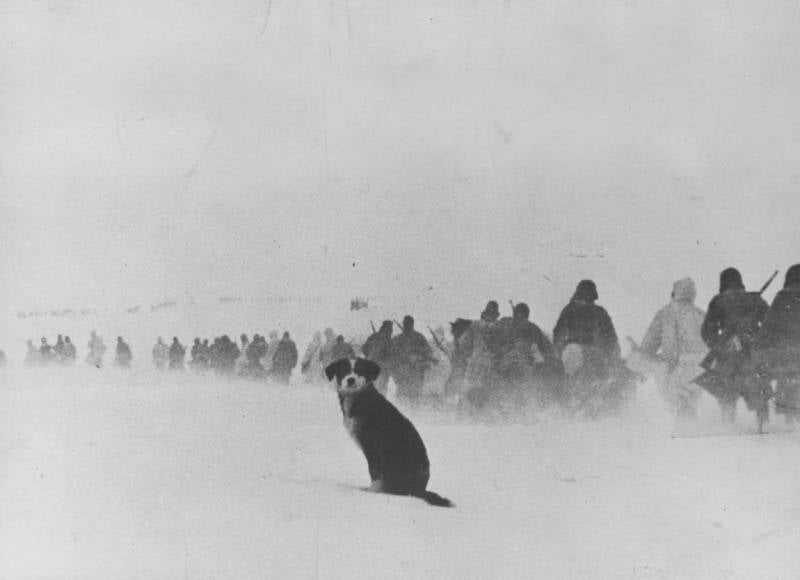
The dog is sitting in the snow on the background of the column of Italian troops, retreating from under Stalingrad
Meanwhile, the offensive of the Soviet troops continued to develop successfully. The main role in this operation was played by tank and mechanized units. The 17, 18, 24 and 25 tank corps of the 1 Guards and 6 armies and the 1 Guards mechanized corps of the 3 Guards army moved rapidly south and southeast into the captured enemy territory, smashing the retreating enemy columns and its rear. Following the mobile units, using and securing their success, the Soviet infantry moved. The enemy threw a large number of vehicles, wagons, ammunition, food and weapons on the roads and in populated areas. Our troops tried to inflict as much damage as possible on the retreating enemy, forming mobile detachments moving on vehicles, tank columns, horse and ski detachments.
The troops of the 6 Army, rejecting the enemy from the areas of Pisarevka and Tala, advanced on Kantemirovka. The tank crews of 17 of December P.N. Poluboyarov's 19 tank corps took this town, turned by the enemy into a strong stronghold. In 12 hours, the 174-I tank brigade broke into the southern outskirts of the city, capturing a station where trains with ammunition and food stood on the tracks. At the same time, an 66 I tank brigade struck from the east, advancing with fights into the central part of the city. Motorized riflemen were thrown to the northern outskirts. In 14 hours, the 31-I motorized rifle brigade approached the city, covering it from the south and southeast. Street battles with the enemy ended in victory for the Soviet soldiers. By evening, Kantemirovka was cleared from the enemy. This success of the 17 tank corps assured the offensive of the entire shock group of the 6 Army. In addition, enemy communication between Voronezh and Rostov-on-Don was cut.
The rapid actions of the 17 tank corps ensured the advancement of parts of the 15 rifle corps of Major General PF Privalov and contributed to the success of the other tank corps (24 and 18). After the liberation of Kantemirovka, Poluboyarov's corps took up defensive positions in anticipation of the approach of the infantry of the 6 Army. In addition, it was necessary to tighten the rear, replenish fuel, ammunition, etc. Soon the 267-division approached, which took defense in Kantemirovka from the 17-second tank corps. Tankers rushed further, and from 22 to 23 in December, the corps led the fighting to capture the settlements of Voloshin, Sulin. During the eight days of the offensive, the tank corps, breaking the resistance of the enemy, made a march on 200 km. Tankers freed around 200 settlements, causing great damage to the enemy. For success in battles in early January, 1943, the 17 tank corps was transformed into the 4 guards tank corps and received the honorary title "Kantemirovsky."
The troops of the South-Western Front, pursuing a departing enemy, December 20 broke through with tank shells in the north-eastern regions of Voroshilovgrad region. As a result, the beginning of the liberation of Ukraine. The 24 and 25 tank corps, developing the attack on Tatsinskaya and Morozovsk, were especially successful in the depths of the German defense. Tankers broke away from the rifle divisions on 110 - 120 km, but continued to move rapidly along their routes, breaking the resistance of the enemy, leaving his unfinished units in their rear.
The 24 tank tank corps of General V.M. Badanov was especially fast moving. Entered into the battle of December 19 corps in five days advanced to a depth of about 240 km, successfully smashing the rear of the Italian Army 8. On December 22, corps units fought in the area of Bolshinka, Ilyinka, where they captured a significant number of prisoners. By the end of December 23 tankers occupied Skosyrskaya. The enemy retreated to Morozovsk, remaining in the rear and on the flank of the Badanov case as they moved to Tatsinskaya.
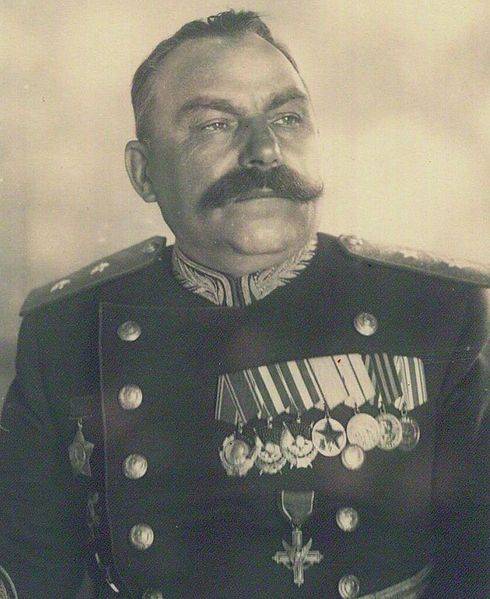
The commander of the 24 tank corps Vasily Mikhailovich Badanov
The enemy front base was located in Tatsinskaya: stockpiles of ammunition, fuel, food, ammunition, and various materials. At Tatsinskaya, was one of the base airfields, which housed aviation, which supported the "air bridge" with the surrounded army of Paulus. That is, this item was of great importance for the enemy army. However, Badanov’s corps experienced an acute shortage of fuel and ammunition; the material part of the compound had to be put in order. And give the fighters rest. Tatsinskaya was another 30 km. Moreover, the enemy had the opportunity to organize flank counterattacks, the neighbors of the 24th tank corps had not yet approached.
Badanov continued the offensive. On the night of December 24, parts of the corps, “having no time to bring the materiel in order, with a small amount of ammunition and fuel,” came out from the Skosirskaya area. At dawn, the Soviet tankers took the starting position to attack. The appearance of our troops at Tatsinskaya was for the enemy a surprise. “The personnel of the airfield was still in dugouts. Gunners anti-aircraft units, covering the airfield and Art. Tatsintsuyu were not at the guns. The enemy garrison was sleeping peacefully. ”
In 7 hour. 30 mines, at the signal of a volley of the Guards mortar division of the corps went on the attack. The 130 Tank Brigade, operating from the south and southeast, cut the Morozovsk-Tatsinskaya railway and the intersection of highways southeast of Tatsinskaya. By 9 hours, the brigade went to the airfield and destroyed the enemy’s aircraft and the flight crew that had been caught off guard. The 2 Tank Battalion of this brigade captured Art. Tatsinskaya, destroying standing on the ways of the train with the aircraft and the train with fuel tanks. 4-I Guards Tank Brigade, striking from the north and north-west, reached the northern outskirts of Tatsinskaya. 54-I tank brigade, attacking from the west and south-west, went to the southern outskirts Tatsinskoy, in the area of the airfield. In 17 hours, tankers, having completely cleared the enemy’s Tatsinskaya station, station and airfield, occupied the all-round defense. During the battle, the enemy garrison was destroyed. Among the trophies there was a large number of aircraft that did not manage to rise from the airfield or captured in the train echelons.
The seizure of the railway station led to the fact that the most important railway communication, Likhaya-Stalingrad, was cut, according to which the fascist command completed the concentration of the Hollidt troops and provided them with everything necessary for conducting combat operations. Thus, the German plan finally collapsed to abandon the troops of the operational group "Hollidt" and the 48 tank corps to release the Paulus group, and these forces were held down by battles with the advancing troops of the Soviet South-Western Front.
The German command took emergency measures to restore the situation in Skosirskaya and Tatsinskaya. In 11 hours by the Germans, the forces of the 11 Tank Division attacked Skosyrskaya and captured it. The rear units of the Soviet corps located there and the tanks remaining for repair went to Ilyinka. However, the Germans attempt to develop the offensive and take Tatsinskaya was repulsed.
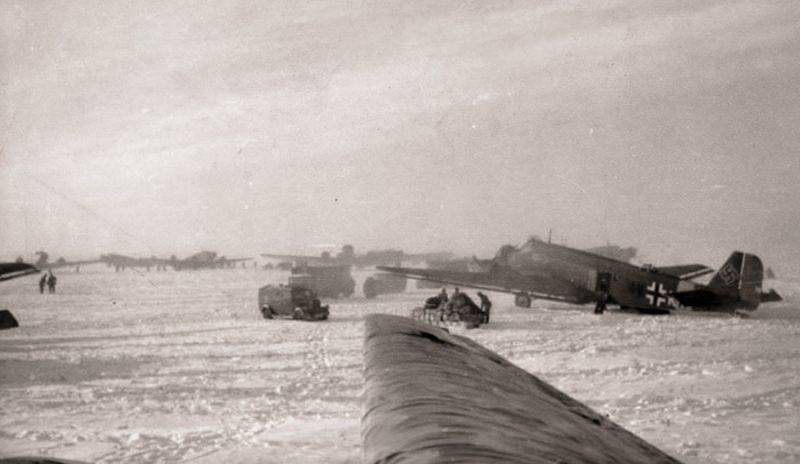
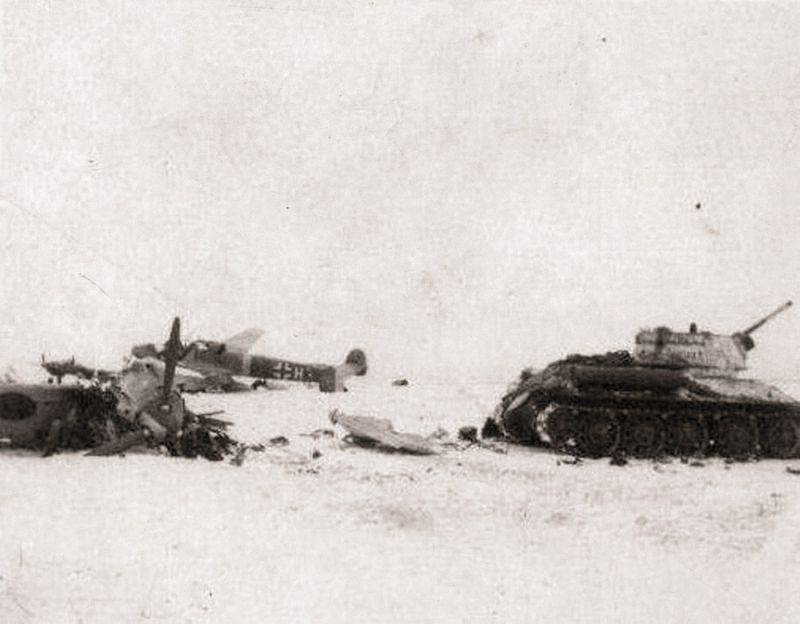
The crushing defeat of the Germans in Tatsinskaya was a vivid episode of the fighting at Stalingrad. Kurt Shraity wrote in the article “On those who escaped from the underworld”: “Morning on December 24 1942. In the east, there is a faint dawn illuminating the gray horizon. At this point, the Soviet tanks, firing, suddenly rush into the village and the airfield. Airplanes immediately flash like torches. Flames raging everywhere. Projectiles are torn, ammunition soars into the air. Trucks are rushing around, and desperate people are running between them. All that can run, move, fly, trying to scatter in all directions. Who will give the order, where to go to the pilots trying to escape from this hell? Starting in the direction of Novocherkassk is all that the general managed to order. The madness begins ... From all sides they go to the launch pad and the planes start. All this happens under fire and in the light of fires. The sky spread a scarlet bell over the thousands who perish, whose faces express insanity. Here is one "Yu-52", not having time to rise, crashes into a tank, and both explode with a terrible roar in a huge cloud of flame. Already in the air, the Junkers and Heinkel collide and fly into small pieces along with their passengers. The roar of tanks and aircraft engines is mixed with explosions, gunfire and machine-gun fires in a monstrous symphony. All this creates a complete picture of the real underworld. ”
The 25 tank corps of Major General P.P.Pavlov, occupying Kashars, advanced in the direction of Morozovsk. The 23 and 24 December corps were fighting hard with the enemy's 306 and 8 airfield divisions. Having broken the resistance of the enemy, the tankers occupied Uryupin by the end of December 24. But further progress towards Morozov was stopped by the increased opposition of the enemy. At this very time, the corps received an order to develop an offensive against Tatsinskaya. In the direction of Morozov, the 1 th Guards Mechanized Corps of Major-General I. N. Russiyanov also advanced.
The troops of the South-Western Front successfully acted on others on the lines of their offensive. The 18 Tank Corps of Major-General Tank Forces B. S. Bakharov, forcing the r. Bogucharki, December 19 took Meshkovo. At the same time, the corps broke forward 35 — 40 km from the advancing rifle formations of the 1 Guards Army. As a result of these bold actions, the Bakharov corps, coming to the Meshkov area, cut off the withdrawal routes from the Don of the main forces of the 8 Italian Army. With the 21 approach in December, the infantry divisions of the 18 tank corps continued to develop the offensive and the next day took Illichivka, Upper Chirsky, and then sharply turned south-westward and began to advance into the Millerovo region.
Using the swift and successful offensive of tank formations, rifle divisions of the 1 Guards Army of December 22 surrounded in the area of Arbuzovka, Zhuravka large forces of the 8 Italian Army: 3, 9, 52 of the Italian, 298 German infantry divisions , Italian infantry brigade "23 March" and "Z of January". The enemy grouping was dismembered, and on December 24 it completely capitulated. 15 Thousands of enemy soldiers and officers were captured. The actions of the 1 and 3 of the Guards armies were also surrounded, and then defeated, the enemy troops also in the areas of Alekseev, Lozovsky, Garmashevka, Chertkovo, Verkhne-Chirskoe, east of Kamensky, in the Kruzhilin area.
Thus, the German front on the Don and Chir rivers was crushed for up to 340 km. The troops of the South-Western Front, moving on 150 - 200 km, by 24 December reached the areas of Kantemirovka, Tatsinskaya and Morozovsk. The airbases of Morozovsk and Tatsinskaya, which were crucial for the supply of Paulus 6, were under attack by the Soviet troops. The further development of the offensive of the front forces was to lead to a deep coverage of the left flanks of the attack groups of the Don army group operating in the Tormosin and Kotelnikov areas and threatened the rear of the North Caucasian grouping of the enemy. In addition, this attack led to the coverage of the right flank of the German-Hungarian troops operating in the Voronezh area. The attacks of the South-Western Front forces in the south-east direction, in combination with the onset of the 24 Guards and 2 armies of the Stalingrad Front in the Kotelnikov direction, which began on December 12, threatened to encircle all the troops of the Don Army Group.
Completion of operation
The German command took extraordinary measures to save the situation and restore the front. Operation Operation Winter Thunderstorm to release Paulus’s army in Stalingrad was finally abandoned by the forces of the Manstein-Goth troops. The Wehrmacht was facing the threat of wider defeat and defeat. The command of the enemy was hastily transferred to the South-Western Front troops, which were originally intended for a deblocking strike on Stalingrad. This was done primarily due to the Tromosinsky group. She never received a number of connections sent to her, taken from other sectors of the front, as well as being transferred from Western Europe. Even the troops that had already participated in the attack of the Goth group were removed, so the main striking force of the army group "Got" - 6-I German Panzer Division was withdrawn from heavy fighting at the turn of the river. Myshkov and thrown on the Middle Don, in the areas of Morozovsk and Tatsinskoy.
The command of the Don Army Group ordered the 3 of the Romanian army, which was holding the front downstream of the Chir River, to free from its site the headquarters of the 48 tank corps with the 11 tank division, to restore their position on the western flank. The 4 Tank Army transferred the 6 Tank Division to engage in defense in Nizhny Cheir. As part of the operational group "Hollidt" a new group "Pfeifer" was formed, which occupied the defense in the Skosirskaya region. To restore the situation in the Millerovo region, the 24 of December was transferred here from Voroshilovgrad and Kamensk-Shakhtinsky 30 German Corps under the command of General Fretter-Picaud (later called the Army Fretter-Picot Group). The following were subordinated to the headquarters of the 30 Corps: the newly formed 304 Infantry Division redeployed from France to the Kamensk region; the Kraising group (its core consisted of parts of the 3 Mountain Division); remnants of the 29 body; remnants of the 298 Infantry Division operating north of Millerovo. In total, the German command was able to additionally send eight divisions against the advancing forces of the South-Western Front.
Fights took a more stubborn character. On the one hand, the shock capability of the Soviet mobile units was weakened, their rear areas were lagging behind, they were far from their supply bases. It was necessary to regroup and replenish the troops with manpower, equipment, materiel. On the other hand, the Germans took hasty measures to restore the front, pulled up troops from other directions and reserves. Using the newly arrived units, the enemy created an advantage in tanks and aircraft in some sectors. Especially brutal battles were fought in areas south of Chertkovo, Millerovo, Tatsinskaya and north of Morozovsk.
The front commander Vatutin ordered 6 and 1 Guards armies to hold their positions, complete the liquidation of enemy troops blocked in the areas of Garmashevka, Chertkov, take Millerovo and complete the exit on the Voloshin, Nikolskaya, Ilyinka, Tatsinskaya line.
The 24 tank corps in the area of Tatsinskaya was blocked by enemy troops and took all-round defense. The enemy concentrated in the area up to two infantry and two tank divisions (11-th and 6-th), our troops were bombed by German aircraft. The Soviet Corps experienced an acute shortage of diesel fuel and ammunition. As of December 25 1942, the corps had 58 tanks in service: 39 tanks T-34 and 19 tanks T-70. Fuel and ammunition were minimal: diesel - 0,2 refueling; 1 gasoline is 2, 2 gasoline is 2, ammunition is 0,5 ammunition.
December 26 1942 in Tatsinskaya arrived from the Ilinka region, accompanied by five T-34 tanks, a convoy that delivered a certain amount of supplies. The corps also came out after a night march of the 24-I motorized rifle brigade. After that, all paths were firmly closed by the enemy. The heavy fuel problem was completely resolved by the enemy’s seized reserves (over 300 tons of 1 gasoline and 2 gasoline, oils and kerosene). The assistant commander of the corps for the technical part of the guard, colonel Orlov, developed a substitute for diesel fuel from captured gasoline, kerosene and oils, which fully ensured the operation of diesel engines. However, the ammunition was very bad. Therefore, Badanov gave the order to save and hit ammunition for targets for sure, and also to use weapon and enemy ammunition.
On this day, our tank troops repelled several enemy attacks. Throughout the day, enemy aircraft launched massive strikes against the combat forces of the corps. Badanov reported with a radiogram to the headquarters of the Southwestern Front and the 1 Guards Army about the acute shortage of ammunition and asked for air supplies. I also asked to cover the corps’s actions from the air and accelerate the advance of army units, ensuring the position of the corps units. J. Stalin instructed: "Remember Badanov, do not forget Badanov, help him out by all means." The Soviet command instructed the 25 tank and 1 guards mechanized corps to assist the 24 corps. However, they could not get through to the aid of the Badanov corps.
During the night on December 27, the enemy continued to concentrate forces around Tatsinskaya and in the morning the Germans continued their attacks. The whole day went hard battles. The enemy managed to penetrate into the defense of the 24 th motorized rifle brigade, but the German 130 th tank brigade threw back the counterattack. When repelling enemy attacks, captured Germans were used. But the situation with ammunition has become critical. 28 December 1942 commander Badanov received permission from the front command to withdraw corps from the environment. At night, the corps with a sudden blow rammed the front of the enemy and left the encirclement in its rear areas in the Ilinka region, the losses during the breakthrough were insignificant. The corps retained its combat capability, and after a few days it fought in the area of Morozovsk.
Monument memorial "Breakthrough". Rostov region
During the raid, Badanov’s corps destroyed more than 11 thousand enemy soldiers and officers, captured the 4769 man, knocked out the 84 tank and 106 guns, only in the Tatsinskaya area destroyed the 10 batteries and 431 aircraft. 27 December 1942 g. The newspaper "Red Star" spoke about the heroes - tankers throughout the country. The Resolution of the Council of People's Commissars of the USSR on assigning Vasily Mikhailovich Badanov the rank of lieutenant-general and the Decree of the Presidium of the Supreme Soviet of the USSR on awarding him with the Order of Suvorov II degree were published The 24 tank corps was renamed the 2 Guards and received the honorary title Tatsinsky.
On the right wing of the South-Western Front, the enemy, pulling up reserves, counterattacked the troops of the 6 and 1 of the Guards armies. However, the enemy failed to succeed. By the end of December, the troops of the South-Western Front advanced to a depth of 200 km and reached the line of Novaya Kalitva - Vysochinov - Belovodsk - Voloshino - Millerovo - Ilyinka - Skosirskaya - Chernyshkovsky. At this Srednedonskaya operation was completed.
Results
During the offensive, Soviet troops liberated 1246 settlements and caused great damage to the enemy. The main forces of the Italian Army 8, the Hollidt task force and the Romanian 3 were defeated. The plans of the German command to create a strike force in the Tormosin area were thwarted, as the troops concentrated here in parts were used in the Middle Don region (Morozovsk, Tatsinskaya). The shock group of Goth, which had broken through to Stalingrad, was weakened. Its main striking force, the 6 Tank Division, was taken straight from the battle. Thus, the idea of releasing Paulus's 6 Army finally collapsed. The Red Army had the opportunity to develop an offensive on the Voroshilovgrad and Voronezh directions.
The troops of the South-West and part of the forces of the Voronezh Front during the December offensive completely destroyed five Italian divisions and three brigades, defeated six divisions. In addition, the four infantry, two tank German divisions were seriously defeated. In these battles, Soviet troops captured 60 thousand soldiers and officers (total enemy losses were 120 thousand people), captured 368 aircraft, 176 tanks and 1927 guns as trophies.
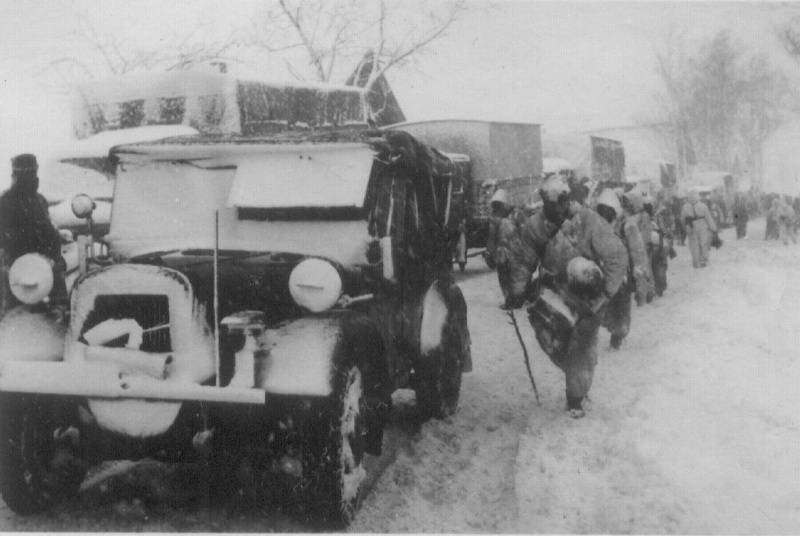
The retreat of the German parts of the group of armies "Don" after an unsuccessful attempt to deploy Stalingrad
8-I Italian army suffered such a defeat that could no longer recover. The rout of the Italian troops on the Don shocked Rome. The relationship between Rome and Berlin has deteriorated dramatically. Duce mode is shaken. Italy soon actually ceased to be an ally of Germany.
As a result, the enemy spent the reserves intended for the attack on Stalingrad, and refused to further attempts to unlock the Paulus group surrounded there, which predetermined its fate and led to a radical change in the situation not only in the Stalingrad-Rostov sector, but on the entire Soviet-German front. Germany was unable to triumphantly complete the 1942 campaign of the year that had begun so successfully. In the Great Patriotic War, a strategic turning point occurred, the Red Army seized the initiative. Only a few days will pass, and the Red Army will launch a general offensive on a broad front.
Monument to the Middle Don operation in the Boguchar district of the Voronezh region
Sources of
Adam V. Difficult decision. Memoirs of Colonel 6 of the German Army. M .: Progress, 1967.
Vasilevsky A. M. The Matter of Life. M., Politizdat, 1983.
Durr G. Hike to Stalingrad. M .: Voenizdat, 1957.
Eremenko A.I. Stalingrad. Notes front commander. M .: Voenizdat, 1961.
Zhukov G. K. Memoirs and reflections. In 2 T.M .: Olma-Press, 2002.
Isaev A.V. When suddenness was gone. History BOB, which we did not know. M .: Yauza, Eksmo, 2006.
Isaev A.V. Myths and truth about Stalingrad. M .: Yauza: Eksmo, 2011.
History of the Great Patriotic War of the Soviet Union 1941-1945 (in 6 volumes). T. 2-3. M .: Voenizdat, 1960-1965.
Kurt Tipelskirch. The history of the Second World War. M .: AST, 2001.
Manstein E. Lost victories. M .: ACT; St. Petersburg Terra Fantastica, 1999.
FV Mellenthin. Tank battles 1939 - 1945: The combat use of tanks in the Second World War. M .: IL, 1957.
Rokossovsky K. K. Soldier debt. M .: Voenizdat, 1988.
Samsonov A.M. The Stalingrad Battle. M .: Science, 1989.
Chuikov V.I. The Battle of the Century. M .: Soviet Russia, 1975.
Shaybert H. To Stalingrad 48 kilometers. Chronicle of tank battles. 1942-1943. M .: ZAO Tsentrpoligraf, 2010.
- Alexander Samsonov
- 1942 Campaign
The Third Reich again goes on the offensive.
"The whole Russian front was falling apart ..." Wehrmacht breakthrough in the southern strategic direction
Stalingrad Fortress
1942 year. "The operation in the south develops without stopping"
How the German army broke through to Stalingrad
Expectations to take Stalingrad a sudden blow failed
Breakthrough of the 6 of the German army to the northern outskirts of Stalingrad
Defeat of the Crimean Front
"The spirit of optimism ... vital at the command post of the front." Kharkov disaster of the Red Army
Khrushchev dumped all the blame for the Kharkov catastrophe on Stalin
How the Wehrmacht stormed the Caucasus
Battle for the Caucasus: no invasions from land
The battle for the "black gold" of the Caucasus
How failed operation "Edelweiss"
"Soviet troops fought for every inch of land ..."
"Verdun of World War II ..."
"It truly was hell." How to reflect the first blow to Stalingrad
"We will storm Stalingrad and take it ...". Second storming of the stronghold on the Volga
The second assault on Stalingrad. H. 2
The third assault on Stalingrad
"Tanks drive through people like wood." The third assault on Stalingrad. H. 2
“We are fighting as if we are possessed, but we cannot make our way to the river ...”
Battle of Stalingrad changed the course of the “Big Game”
The German command is focused on "extremely active" defense and "a sense of superiority of the German soldier over the Russians"
"Stalin's holiday": Operation "Uranus"
"Stalin's holiday": Operation "Uranus". H. 2
Stalingrad "boiler"
Bloody Mars
Bloody Mars. H. 2
As the Germans tried to save the army of Paulus. Operation "Winter Thunderstorm"
"Winter Thunderstorm." H. 2
How to stop the breakthrough of the army group "Got"
How failed Manstein offensive
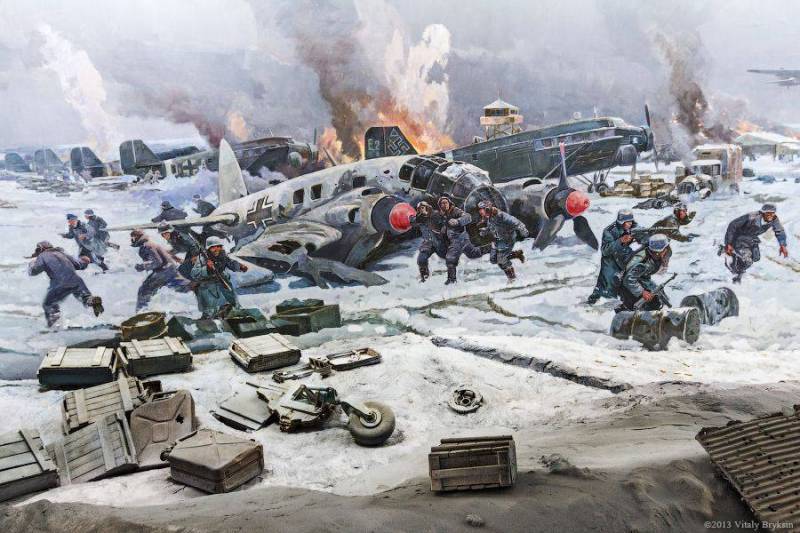
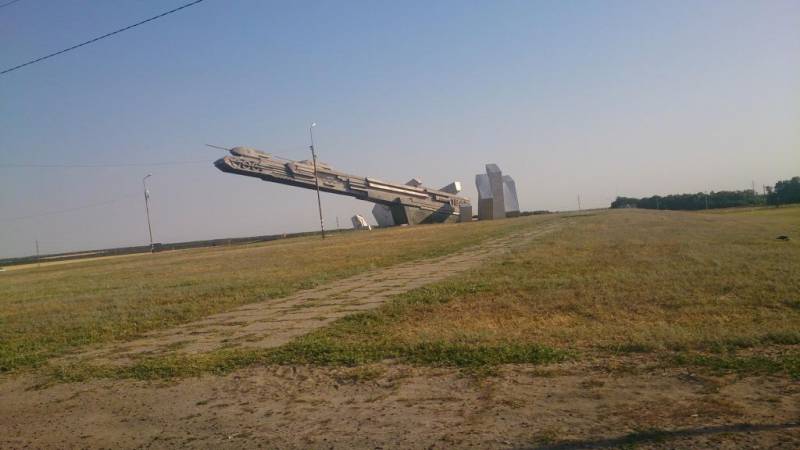
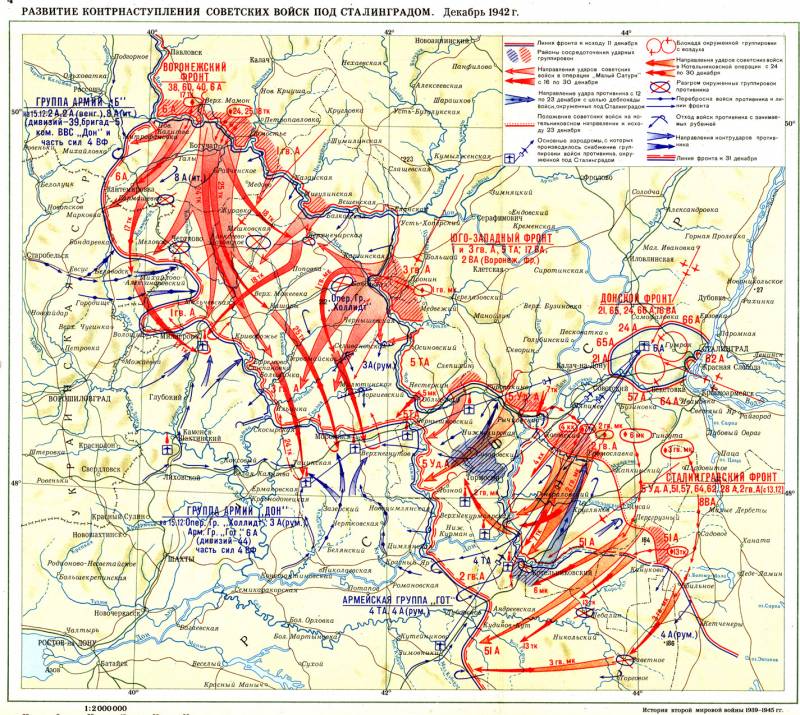
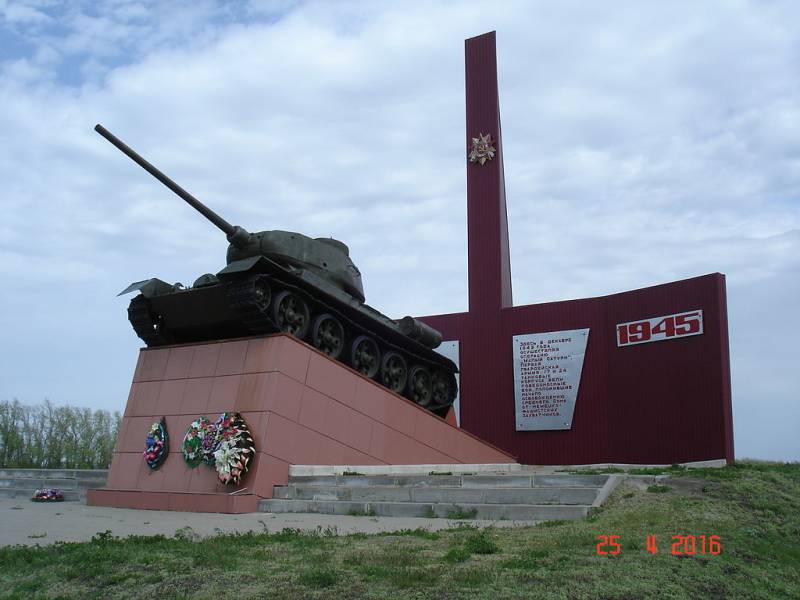
Information